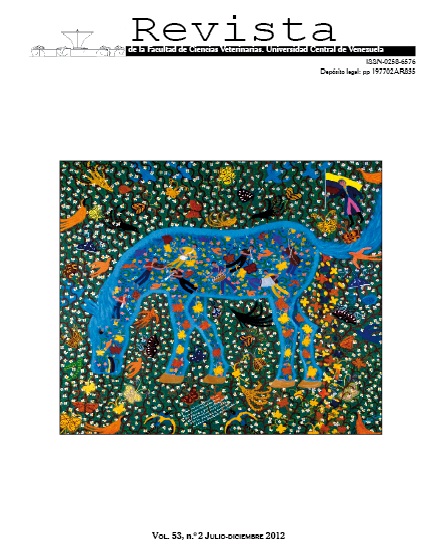EVALUACIÓN DEL DESARROLLO DE BABAS (Caiman crocodilus crocodilus) ALIMENTADAS CON UNA DIETA MEDICADA CON ANTIBIÓTICO
Contenido principal del artículo
Resumen
La baba, Caiman crocodilus crocodilus, criada en cautiverio puede sufrir estrés, que unido a otros factores, promueve el retraso y mortalidad en la época crítica de crecimiento, por lo que algunos algunos autores reportan el uso de antibióticos para contrarrestar estos efectos. Se evaluó el crecimiento de babas en cautiverio alimentadas con una dieta medicada con antibiótico (virginiamicina) y poblaciones con dieta no medicada, tomando como indicadores: medidas del largo total, grosor del cuello y grosor de la base de la cola y el peso de los animales. Se utilizaron 600 babas nacidas por incubación en el zoocriadero Kiubo (La Suareña, estado Aragua). Estos animales fueron medidos, pesados y evaluados clínicamente antes del inicio del ensayo y distribuidos al azar en un tanque tipo australiano (4 secciones). Las dietas fueron: Tratamiento 1: alimento comercial + proteína animal fresca, y Tratamiento 2: alimento comercial + antibiótico + proteína animal fresca. El análisis estadístico fue un diseño completamente aleatorizado, con evaluaciones en tres etapas o fases: Inicial, Intermedia y Final. En la fase inicial se encontraron diferencias significativas (P≤ 0,05) para todas las variables, siendo el tratamiento 1 el que resultó con mayores promedios. En la fase intermedia se observaron diferencias significativas (P≤0,05) para grosor de la base de la cola, largo total y peso; el grosor del cuello no presentó diferencia significativa. En la fase final se, detectaron diferencias significativas (P≤0,05) entre los tratamientos para la base de la cola y largo total; para el grosor del cuello y peso no hubo diferencias significativas. Se observó que el tratamiento 1 fue mejor que el tratamiento 2, para algunas variables, pero ambas dietas contribuyeron al incremento de la tasa de crecimiento, concluyéndose que no se recomienda el uso de antibióticos adicionados a la dieta, ya que incrementa los costos de producción y puede contribuir con la resistencia bacteriana en el hombre, mientras la cría en cautiverio de esta especie, depende principalmente del buen manejo de los mismos.
(Palabras clave: Evaluación, crecimiento, Caiman crocodilus crocodilus, cautividad, alimentación de los animales, dieta, antibióticos, costos de producción, Aragua
Abstract
The spectacled caiman (Caiman crocodilus crocodilus) is a species raised in captivity that can suffer from stress, which, along with other factors, promotes growth delay and mortality during the critical time of growth. Some investigators report the use of antibiotics to counteract those effects. The growth of a population of spectacle caimans raised in captivity and fed with a diet supplemented with antibiotic (virginiamycin) was compared with the growth of the spectacle caiman population fed with a control diet was assessed. A total of 600 animals born through incubation at the Kiubo farm were used. Before the onset of the experiment, the animals were measured, weighed, clinically evaluated, and randomly distributed in four sections in an Australian tank. The following variables were measured using a metric tape: total length (TL), neck thickness (NT), base of the tail thickness (BTT). The weight was recorded with an electronic balance. The animals were submitted to the following treatments (T): Treatment 1 (T1): commercial diet + fresh animal protein; Treatment 2 (T2): commercial diet + fresh animal protein + antibiotic. The evaluations were carried out in three phases: Initial phase, Intermediate phase, and Final Phase. A totally randomized design with a covariance analysis was performed to analyze the data. The results show that during the initial phase, all variables showed statistically significant (P≤0.05) differences, reaching T1 the highest averages. During the intermediate phase, significant differences (P≤0.05) were found for BTT, TL, and weight. The NT was not significant. During the final stage, statistical differences (P≤0.05) were recorded among T for BTT and TL, but no differences were found for NT and weight. For some variables, T1 was better than T2, but both diets contributed to the increment of growth rate. It is concluded that the use of antibiotics supplemented in the diet, increases production costs and that breeding in captivity depends more on good handling.
(Key words: Evaluation, growth, Caiman crocodilus crocodilus, captivity, animal feeding, antibiotic), diet, antibiotics, production osts, Aragua)

